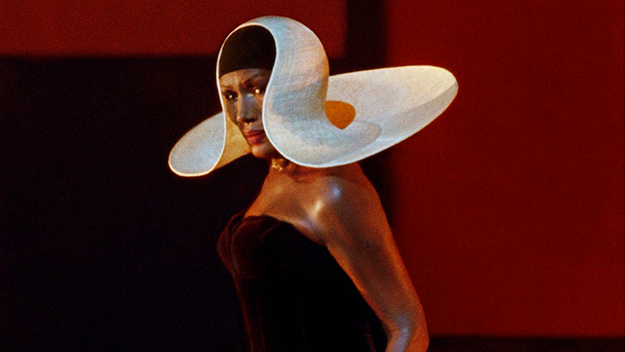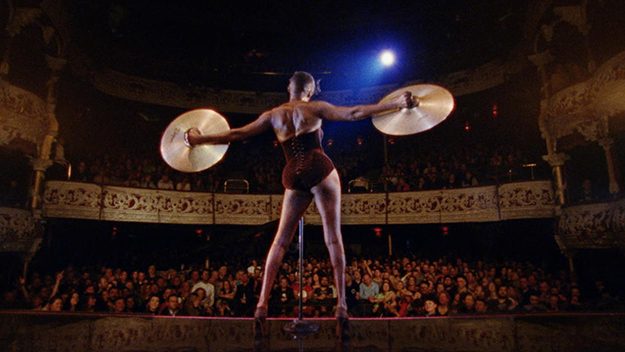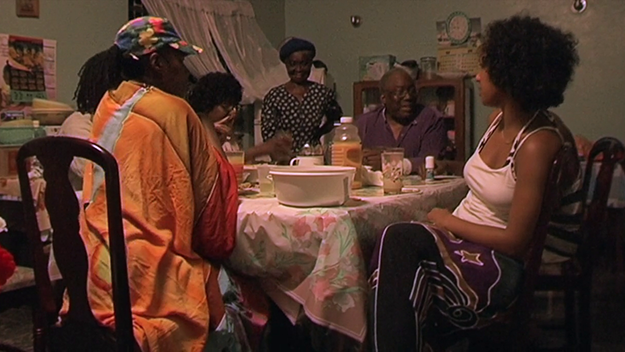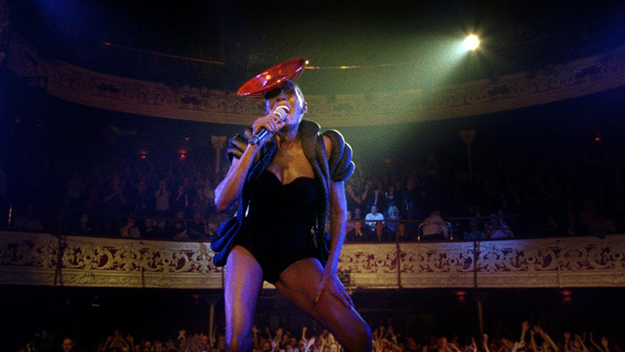Film of the Week: Grace Jones: Bloodlight and Bami

At least since D.A. Pennebaker’s Dylan portrait Don’t Look Back, it has been understood that the real performance moments in a music documentary don’t happen on stage. They take place behind the scenes, in the dressing room, where the artist doesn’t let slip the mystique slip, but instead simply mounts a different kind of show: a heightened display of the “real” self for the camera’s benefit. We get a fair few such moments in Sophie Fiennes’s Grace Jones: Bloodlight and Bami, in which, as you might expect, the singer treats us to one or two regal snits. In one such imperious rage, Jones berates a man named Michael over the phone—“CALL ME WHEN IT’S DONE!”—then self-consciously milks the moment. “Ah, the fucking panther’s coming out in me now,” she snarls before wryly singing to herself, “Heads are gonna roll…”—then paraphrases a line from Dolores Claiborne, “Sometimes you have to be a high-flying bitch.”
Jones may not always play the bitch in this movie but boy, is she ever high-flying. Shot over five years by the British director best known for her two Pervert’s Guide films about Slavoj Zizek, Bloodlight and Bami catches the singer in Moscow, New York, and Paris, on stage in Dublin and in the recording studio, and with her family in Jamaica. The non-chronological editing oddly makes Jones look as if she’s everywhere at once, unbounded by the laws of time and space that ordinary mortals are subject to.
Her music too seems immune to the normal laws of pop fashion. Seeing her perform hits from the peak of her stardom, it’s extraordinary how, while these songs have precious little in common with today’s pop or dance styles, they can’t easily be pigeonholed as ’80s music, whereas so much then-fashionable product now sounds quaintly of its time. When she covers Roxy Music’s “Love Is the Drug,” you become aware of how powerfully her coolly ironic (and aggressively iconic) stance has endured, while the mystique of the song’s co-writer Bryan Ferry has worn thin over decades of gesturing at tasteful sincerity. True, Jones has allowed herself to become frozen in time and in a certain image—and maybe cultivated that state of suspension. Performed live, “Pull Up to the Bumper” et al sound exactly the way you remember them, and Jones looks and performs the way you expect her to—only more so (and it’s amazing that a song so entirely dependent on lurid innuendo nevertheless sounds so suavely classy).

The musical segments of the film include Jones on stage, as well as in the studio preparing her 2008 comeback album Hurricane—which offered some glimpses of a personal backstory, with the song “Williams Blood,” heard here, chronicling Jones’s Jamaican family history. We see the singer on the phone trying to pin down legendary bass player Robbie Shakespeare to a recording date, pointing out that she doesn’t have a label and is paying for the sessions herself; she gets cut off and you realize, wow, even Grace Jones is subject to the vagaries of earthly phone communications. When we see Shakespeare in the studio, his playing is complex and thunderous; musos will also relish a close-up of the fingers of percussion legend Sly Dunbar as he taps out a rhythm on a drum machine.
What people will really gravitate to in this film is its promise to uncover something of the inner life. Well, we get some of that, and we don’t. Much of Bloodlight and Bami shows Jones visiting her family in Jamaica: the title, although it’s never explained here, combines the Jamaican slang for the red light of the recording studio, and a local cassava flatbread. We see the singer among her family, with her mother, her son (and percussionist) Paulo, an adult niece visiting the island for the first time, and siblings including brother Bishop Noel Jones, whose L.A. ministry was the subject of Fiennes’s 2002 documentary Hoover Street Revival. Grace is relaxed and cheerful, leaving her star self, the intergalactic dominatrix, behind. And yet you don’t feel that she completely stops performing. Up in the hills, leaning out of a car to photograph a magnificent view, she drawls, “That is just absolutely breathtaking,” and you hear the English tones of a cosmopolitan fashionista, just one Knightsbridge mews away from Absolutely Fabulous. At other moments, her speaking voice is totally Jamaican, or American, or bizarrely (given that she’s speaking English at the time) French. In everyday life, her identity seems perplexingly fluid, but the stage performances maintain a strangely monolithic sense of the performer as a living, moving statue.
In the Jamaican sequences, we do get a glimmer of a sense of, not necessarily who Jones is but who she once was—although we must imagine for ourselves how she became the self-created marvel we know. Grace in a family setting, blending in (more or less) with the chat at table—that’s certainly something we’ve never seen, and a visit to an elderly neighbor from her childhood days, Miss Myrtle, provides a nice off-guard moment. When Myrtle says that she still has some of the spinning jacks that the Jones children used to play with, Grace bursts into a flurry of excited arm movements. The gesture is a little knowing, even arch, but at least Jones is revealing that she was a child once. At one point, the camera holds at length on a young Jamaican girl sitting outside a church, as if daring us to imagine that this is what our familiar Amazon once was—or that this girl too might one day undergo her own Graceian transformation.

There are some more overt revelations, when the singer and siblings reminisce about Mas P, their grandmother’s second husband, a ferocious religious disciplinarian who ruled the children with a rod of iron—or rather, an array of leather straps of different sizes that hung in a row, each with its own name. Three children who were found huddled for play in a barrel were subjected to a two-week courtroom-style trial; lashings would be given for watching TV; and the kids were expected to read the Bible while taking a beating. One of two deeply personal revelations comes here, although you imagine it’s one that Jones has rehearsed over the years, possibly in therapy sessions: the awareness that in her own persona as a performer, Jones internalized the figure she grew up fearing: “I was playing out Mas P… that male dominant scary person that I became.”
The other revelation, although again it has an element of shtick, comes at a photo session with French photographer Jean-Paul Goude, the man who created the classic but much-contested images of Jones as an ironically eroticized arch-African goddess from Mars (frequently criticized for both racism and sexism, the image clearly resonated with black audiences: note the female warriors in Black Panther, announced by one awe-struck character as “Grace Jones-looking chicks”). Jones leans towards Goude and says to him—although you can’t believe she’s really saying it for the first time— “You’re the only man who made me buckle at the knees,” recalling the butterflies she felt when visiting him in New York. Because the Goude we see is a wizened gent of a certain age, wearing ridiculous white pierrot socks and huge glasses he must have acquired in 1982, you can’t help believing her.
Possibly the truest thing that Jones says about herself comes on the set of a French TV show on which she performs her 1977 disco cover of “La Vie en Rose.” The production has her surrounded by a troupe of writhing female dancers in white deshabille, and Jones can’t believe how tacky it is; she says she’d rather do it without the dancers, but says she’d feel bad about them wasting their time and effort. She’s quite right, the routine is awful: “C’est très bizarre… I am like a madam in a whorehouse. Je suis comme une lesbienne madame.” Then the clincher: “We are visual artists, we know what things look like.”

That’s exactly it: Jones is a visual artist who knows what things look like, and above all, knows what she looks like (she seems to have an unerring skill applying her own elaborate make-up). Together with Goude and an army of musicians, producers, stylists, and designers, Jones at a key moment in her career created a single dazzling persona and accompanying routine—a highly derivative one that blends Marlene Dietrich, Eartha Kitt, Mae West, and Josephine Baker, and that has more to do with European cabaret than with American pop. Unlike Bowie and Madonna, she found one big idea—a domineering, voracious cartoon of polysexual desire, and one that’s oddly weightless and abstract, despite its dependence on her singular physicality. She’s found this idea and stuck to it, and still sticks to it now, as the film shows, with only minimal variation. And again, unlike Bowie and Madonna, she has maintained ferocious standards of quality control, partly by releasing relatively little product.
Jones is seen in Bloodlight and Bami cheerfully mythologizing herself, both as a performer (“If the electricity goes . . . I can still perform, I can still hold the audience in the dark, without any trimmings”) and as a woman with a short fuse (“I don’t strike without a warning—lovers, husbands, boyfriends, I always give a warning”). But someone who gets the figure she does hardly needs to talk the talk. Now 69, she’s in startlingly muscular and athletic form in the film’s live sequences. One trick that Fiennes misses—although perhaps intentionally, so as not to overwork a show-stopper—is to grant us only a snippet of the moment in Jones’s act when she spins a hula hoop for the entirety of “Slave to the Rhythm” (“Keep it up, keep it up…”). There are even a couple of brief glimpses of Jones naked, and you can’t believe the shape she’s in. What’s her secret? Is she like Countess Elizabeth Bathory, bathing in the blood of those Parisian dancers? Wearily protesting on the phone, negotiating those tricky Jamaican studio sessions, Jones sighs, “I’m human, man, I’m human.” Fiennes’s entertaining film goes some of the way to proving her right—but ultimately, I don’t think we really want to believe it.
Grace Jones: Bloodlight and Bami opens Friday 13 at the Film Society of Lincoln Center.
Jonathan Romney is a contributing editor to Film Comment and writes its Film of the Week column. He is a member of the London Film Critics Circle.







